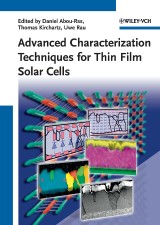Details

Advanced Characterization Techniques for Thin Film Solar Cells
1. Aufl.
|
108,99 € |
|
| Verlag: | Wiley-VCH |
| Format: | |
| Veröffentl.: | 12.05.2011 |
| ISBN/EAN: | 9783527636303 |
| Sprache: | englisch |
| Anzahl Seiten: | 585 |
DRM-geschütztes eBook, Sie benötigen z.B. Adobe Digital Editions und eine Adobe ID zum Lesen.
Beschreibungen
Written by scientists from leading institutes in Germany, USA and Spain who use these techniques as the core of their scientific work and who have a precise idea of what is relevant for photovoltaic devices, this text contains concise and comprehensive lecture-like chapters on specific research methods.<br> They focus on emerging, specialized techniques that are new to the field of photovoltaics yet have a proven relevance. However, since new methods need to be judged according to their implications for photovoltaic devices, a clear introductory chapter describes the basic physics of thin-film solar cells and modules, providing a guide to the specific advantages that are offered by each individual method. <br> The choice of subjects is a representative cross-section of those methods enjoying a high degree of visibility in recent scientific literature. Furthermore, they deal with specific device-related topics and include a selection of material and surface/interface analysis methods that have recently proven their relevance. Finally, simulation techniques are presented that are used for ab-initio calculations of relevant semiconductors and for device simulations in 1D and 2D.<br> For students in physics, solid state physicists, materials scientists, PhD students in material sciences, materials institutes, semiconductor physicists, and those working in the semiconductor industry, as well as being suitable as supplementary reading in related courses.<br>
I Introduction <br /> 1. Introduction to thin-film photovoltaics<br /> II Device characterization<br /> 2. Fundamental electrical characterization of thin-film solar cells<br /> 3. Electroluminescence analysis of thin-film solar modules<br /> 4. Capacitance spectroscopy of thin-film solar cells<br /> III Materials characterization<br /> 5. Characterizing the light trapping properties of textured surfaces with scanning near-field optical microscopy<br /> 6. Ellipsometry<br /> 7. Photoluminescence analysis of Si and chalcopyrite-type thin films for solar cells <br /> 8. Steady state photocarrier grating method <br /> 9. Time-of-flight analysis<br /> 10. Electron Spin Resonance on Si thin films for solar cells <br /> 11. Scanning probe microscopy on thin films for solar cells<br /> 12. Electron microscopy on thin films for solar cells <br /> 13. X-ray and neutron diffraction of materials for thin film solar cells<br /> 14. Raman Spectroscopy on thin films for solar cells <br /> 15. Soft x-ray and electron spectroscopy: a unique "tool chest" to characterize the chemical and electronic properties of surfaces and interfaces<br /> 16. Elemental distribution profiling of thin films for solar cells <br /> 17. Hydrogen effusion experiments<br /> IV Materials and device modelling<br /> 18. Ab-initio modelling of semiconductors <br /> 19. One-dimensional electro-optical simulations of thin film solar cells<br /> 20. Two-dimensional electrical simulations of thin film solar cells
"Written by scientists from leading institutes in Germany, USA and Spain who use these techniques as the core of their scientific work and who have a precise idea of what is relevant for photovoltaic devices, this book contains concise and comprehensive lecture-like chapters on specific research methods". (ETDE Energy database, 2011) <p> </p>
<p><b>Uwe Rau</b> is full professor at RWTH Aachen (Faculty Electrical Engineering and Computer Science, chair of photovoltaics) since 2007 and is head of the energy research IEF-55 photovoltaic institute at the research center in Jülich. He obtained his PhD 1991 from Physical Institute of the University Tübingen (Prof. Huebener) and was scientific group leader from 1995-2007 at the University Bayreuth and Stuttgart.</p> <p><b>Daniel Abou-Ras</b> is senior scientist at the Helmholtz Center Berlin for Materials and Energy. He obtained his PhD at ETH Zurich, Switzerland. In 2005, he earned the MRS Graduate Student Gold Award at the MRS Spring Meeting. His research interests are scanning as well as transmission electron microscopy techniques applied on thin-film solar cells. Dr. Abou-Ras has organized various Young Scientist Tutorials on characterization techniques for thin film solar cells held at MRS and E-MRS Meetings.</p> <p><b>Thomas Kirchartz</b> is a scientist at the Institute of Energy at the research center in Jülich. He obtained his Dipl. Ing. degree from the University of Stuttgart for work on the electroluminescence of solar cells in 2006 and his Dr. Ing. from the RWTH Aachen in 2009 for work on a detailed balance theory of solar cells. Dr. Kirchartz participated as instructor in two Young Scientist Tutorials on characterization techniques for thin film solar cells and was awarded a Graduate Student Award of the European Material Research Society.</p>
<b>W</b>ritten by scientists from leading institutes in Germany, USA, Spain, Sweden, Poland, and Israel who use these techniques as the core of their scientific work and who have a precise idea of what is relevant for photovoltaic devices, this text contains concise and comprehensive lecture-like chapters on specific research methods. <p>The choice of subjects is a representative cross-section of those methods enjoying a high degree of visibility in recent scientific literature. A clear introductory chapter describes the basic physics of thin-film solar cells and modules, providing a guide to the specific advantages that are offered by each individual method. Furthermore, the handbook deals with specific device-related topics and includes a selection of material and surface/interface analysis methods that have recently proven their relevance.</p> <p>Finally, simulation techniques are presented that are used for ab-initio calculations of relevant semiconductors and for device simulations in 1D and 2D.</p> <p>For students in physics, electrical engineering, and material sciences, solid state physicists, electrical engineers, materials scientists, semiconductor physicists, scientists working at materials research institutes, and those working in the semiconductor industry. Also suitable as supplementary reading in related courses.</p>

















